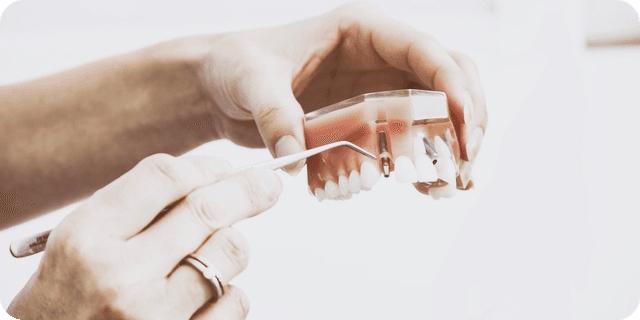Specialized Procedures
Tooth Extraction Essentials: A Step-by-Step Guide
Navigate the process of tooth extraction—from reasons behind it to aftercare tips for a smooth and comfortable recovery.
5 min read
Sep 24, 2024

Tooth Extraction: Setting the Stage
Pulling a tooth sounds medieval, yet tooth extraction is a common dental procedure performed thousands of times a day by an oral surgeon. One of the most common reasons for tooth removal is a tooth beyond repair from deep tooth decay or a crack that split the crown like firewood. Removing the affected tooth can prevent infection from spreading to the gum and the tooth and surrounding bone.
Reasons for Tooth Extraction
Your dentist may recommend taking a tooth from its socket for several solid, science-backed reasons:
Impacted wisdom teeth crowding their neighbors.
A damaged tooth broken off at the gum line.
Severe periodontal disease eating away support.
Orthodontic prep or space for dental implants.
Whatever the trigger, it’s essential to understand the reasons for tooth extraction so you feel in control.
The Extraction Process
When you arrive at the dental office, the procedure begins with a little paperwork, a short chat, and numbing medicine that works faster than your streaming service loads a movie. The dentist loosens your tooth with a gentle rocking motion—think doorknob wiggle, not brute force—and lifts the tooth from its socket. For stubborn molars, the extraction might require sectioning the crown, but you’ll feel only pressure, not pain.
Socket Science: Blood Clot and Healing
Immediately after the tooth is removed, a blood clot at the extraction site forms. That clot is nature’s Band-Aid, sealing off the socket so new tissue can grow. Keep the area for the first 24 hours calm: no rinse, no spit, no straw. Disturbing the clot at the extraction site invites misery known as a dry socket—an empty hole that throbs like a drum solo at 3 a.m.
First 24 Hours: Guarding the Extraction Site
Essential step number one: bite down on the gauze pad your dentist gives you for at least 24 hours or until bleeding slows. Swap it for a fresh piece if it feels soaked. Normal for the first hour: pink saliva. Not normal: persistent bleeding at the extraction site that soaks gauze after several swaps. If that happens, call your dentist.
Bleeding, Swelling, and the Ice Pack
Mild bleeding and chipmunk cheeks are part of the healing process. An ice pack wrapped in a washcloth, fifteen minutes on and fifteen off, keeps swelling manageable. Over-the-counter pain relievers tame tenderness. If severe pain or swelling spikes on day three, contact your dentist because infection can delay healing. Learn more about toothache causes and remedies.
Rinse and Repeat—But Not Too Soon
Avoid rinsing the first day. Starting day two, keep the area clean with a saltwater rinse (½ teaspoon salt in warm water) after meals. Swish gently around the extraction site; aggressive gargling can dislodge the clot and irritate the extraction site.
Soft Foods and What to Skip
Comfort foods like mashed potatoes, yogurt, scrambled eggs, and cool smoothies are your new best friends. Avoid hard or crunchy foods like chips, nuts, or crusty bread—they can scratch the gum near the extraction site. Also essential: avoid hot soup the first few days, and avoid alcohol for at least 24 hours because booze thins your blood and can fuel bleeding.
Strenuous Activities? Not Yet
Avoid strenuous activities and any exercise that jacks up heart rate during the first few days. Strenuous activities raise blood pressure, which may restart bleeding and delay healing. Couch surfing is doctor’s orders.
Essential Tips for a Smooth Recovery Process
Follow your dentist’s instructions, even the ones that feel fussy.
Keep gauze in place until bleeding stops, then swap for fresh if needed.
Stick to soft foods and plenty of water; avoid drinking through straws.
Brush the rest of your teeth, but be gentle around the extraction site, and avoid brushing directly on the stitches.
Avoid smoking—it can sabotage healing and cause dry socket. Learn more about oral wellness beyond extractions.
These essential tips promote healing and ensure a smooth recovery process.
Dry Socket: The Villain You Can Beat
If a clot never forms or gets dislodged, the socket bone is exposed, leading to dry socket. The pain is unmistakable—sharp, deep, and often radiating toward the ear. Tooth extraction may feel easy until this shows up. Call your dentist right away; they’ll place a medicated dressing that soothes pain and jump-starts healing.
Over-the-Counter Pain Relievers and When to Call
Ibuprofen and acetaminophen handle most discomfort. Combine them (per dosage instructions) for stronger relief. If severe pain persists despite medication, or you notice foul odor, pus, or fever, avoid complications and ensure safety: contact your dentist.
Avoid Smoking and Other Healing Hazards
Nicotine constricts blood vessels, starving the socket of oxygen. Avoid smoking for at least 48 hours—longer is better. Also, avoid hot showers on day one, avoid hard candy, and avoid strenuous nose-blowing that can create pressure and dislodge the clot.
Follow-Up and Dental Implants
Once your gum closes and bone fills in, missing-tooth decisions arrive. A gap left unattended lets neighboring teeth drift like bored shoppers. Talk to a dental professional about bridges, partials, or dental implants. Replacing the tooth can prevent shifting and protect overall oral health.
Frequently Asked Questions
Should I brush my tongue? Yes—bad breath sneaks in otherwise. Just be gentle around the extraction site.
Can I drink coffee? Lukewarm is okay after the first 24 hours. Avoid hot for now.
Can I sleep flat? Prop your head slightly with pillows to reduce bleeding.
Ice cream? Absolutely, as long as you eat with a spoon and choose soft flavors without nuts.
Recap: Guide You Through the Process
Let’s recap the journey. Tooth extraction is a common dental procedure done to protect oral health, whether from tooth decay, impacted wisdom teeth, or orthodontic needs. Your dentist will guide you through the process, loosen your tooth, and remove it smoothly. The first 24 hours are crucial: protect that blood clot, keep pressure with gauze, and rest. Over the next few days, eat soft foods, use an ice pack, and avoid strenuous exercise. Follow your dentist’s instructions, keep the area clean with gentle saltwater rinses, and don’t hesitate to call your dentist if anything feels off.
Take these steps to heart and your extraction experience will be straightforward. You’ll trade short-term downtime for long-term comfort, avoid complications, and ensure a smooth recovery. Then you can get back to crunchy apples, radiant smiles, and, if you like, planning for new dental treatments like implants or bridges. After all, taking care of one small spot today keeps your mouth—and you—happy tomorrow.
Read Next
Related Posts

Specialized Procedures
Emergency Wisdom Tooth Removal Guide: Costs, Pain, and Recovery
Got a throbbing pain in the back of your mouth that’s making it impossible to eat, sleep, or think straight? You’re probably not just being dramatic—your wisdom teeth might be staging a full-blown rebellion. Whether they’re pushing against other teeth, swelling up your gum, or causing a surprise infection, sometimes the only fix is fast, professional help.
6 min read
Jun 23, 2025

Specialized Procedures
Emergency Root Canal 101: Fast Action for Infected or Damaged Teeth
If your tooth is throbbing like a drum and even breathing feels like too much, you might be dealing with more than just a bad day—you could need an emergency root canal. When decay, infection, or trauma strikes deep inside a tooth, fast action isn’t optional, it’s essential.
6 min read
Jun 23, 2025

Specialized Procedures
Top Tooth Extraction Pregnancy Risks and How to Minimize Them
A nagging toothache is never fun—but when you're pregnant, it’s a whole different story. Suddenly, every decision feels loaded: Is it safe to get a tooth pulled? Will dental work harm the baby? If you’re dealing with a painful dental issue during pregnancy, you're not alone—and you're not out of options either.
6 min read
Jun 18, 2025
Don’t have time to research every dentist around you?
See why 30k+ patients trusted us